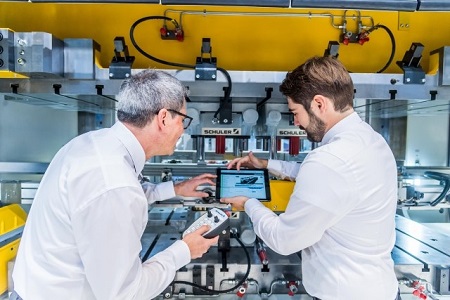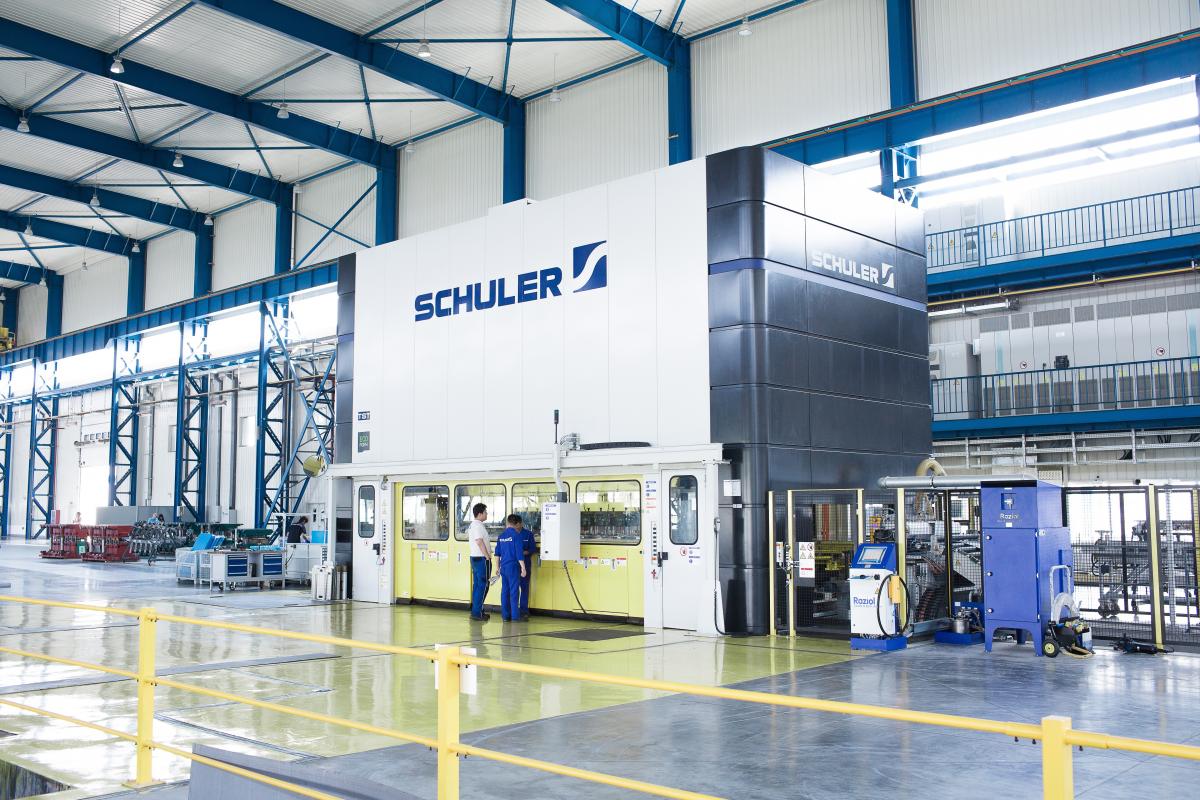
Schuler’s “Smart Assist” accelerates the production startup by guiding the user step-by-step through the process.
Sophisticated sensors and actuators in the latest Schuler machines make it possible – whether mechanical transfer presses, hydraulic hot stamping or composite lines, for instance.
In Schuler presses, machine components can be monitored for changes, wear, and damage to optimise the maintenance process. For this purpose, regular test runs of the system are performed in which vibration data, torque progressions, and energy consumption, among other things, are measured, stored, and compared. Sensors in the press bed and slide record the acceleration per stroke for example, enabling stampers to monitor the forming processes in detail.
The most recent example is the completely redesigned MC 125 stamping press. Thanks to additional integrated sensors, its condition can be fully monitored at all times. This ensures the productivity of the stamping machine. The functionalities are also available on mobile devices.
However, digital solutions can also help to accelerate the production startup significantly. Schuler’s servo presses come with a software, called “Smart Assist” which guides the user through the process step-by-step with the aid of videos and graphics, optimises the movement curves of the slide and transfer fully automatically, and transfers the data to the overall system. Compared to setting up the system manually, which can take up to eight hours for an expert, the Smart Assist reduces the process to just 30 minutes.
Track & trace with pinpoint accuracy
Compared to cold forming, significantly more factors influence the production process in hot stamping, which is usually done with hydraulic presses. Here, Schuler’s process monitoring solution records the exact temperature of the red-hot blanks as they leave the furnace, the amount of time that passes before they are placed in the die, the press force applied, and many other things. All of these parameters have a direct effect on the part quality. In case there is any doubt, stampers can track and trace these parts with pinpoint accuracy.
Hot stamping 4.0
The process of press hardening, also referred to as hot stamping in the metal forming industry, depends on a number of influencing factors: the exact temperature of the red-hot blanks when leaving the furnace, the amount of time that passes before they are placed in the die, the press force applied, and many other things. All of these parameters have a direct effect on the quality of the parts, which is why it should be possible to seamlessly document and, in the case of any doubt, track and trace these parts with pinpoint accuracy.
The first system that Schuler networked with the solution’s software was its hot stamping line in the Hot Stamping TechCenter at the company headquarters in Göppingen. Video and thermal imaging cameras provide a real-time overview of the blank feed, transfer and parts exit sections, all while the system continuously records and documents process data (referred to as process monitoring). The information is collected by the numerous sensors installed in the press, die, furnace and cooling units. These powerful sensors detect even the slightest changes in temperature, pressure, vibration characteristics and flow rate in intervals measuring just fractions of a second.
As this is happening, the process monitoring system from Schuler is able to not only combine the huge quantities of data collected by the sensors at many megabytes per second, but also to synchronise this data across all of the different interfaces. To ensure that the correct and necessary information is available at any given moment, algorithms analyse the data and keep the amount of memory used to a sensible size. This makes it possible to visualise long-term trends for various different types of process data.
Identify error sources at a glance
The solution gives system operators a way to track and trace each and every hot stamped part down to every last detail and, with the help of data histories, check whether blanks were heated to a high enough temperature, kept in the press long enough, or were cooled in the proper amount of time. Possible error sources or causes of production disruptions can be identified at a glance—whether a burner in the furnace has suddenly failed or the hot stamping die has steadily lost precision over time.
Manufacturers, especially those of safety-related components, are currently facing growing demands from a number of different areas calling for the ability to account for the continued existence of optimal production conditions, e.g., for hot stamped B pillars, over a span of many years. The newly developed solution from Schuler—which goes by the title Machine Monitoring System (MMS)—also detects any instances where a system operator manually adjusts settings on the line without documenting the change. This also ensures that no critical information is lost in the communication with production management, for example.
Not only does the software run on-site in the line control, it can also be used everywhere else as a standalone application on any Windows computer. From these other computers, users can access data on the company’s secure network over a protected connection. Schuler also plans to incrementally expand the system to include additional functionality, such as predictive maintenance.
Smart assist makes setup easier
Setting up transfer presses is often a task reserved for absolute professionals: Harmonising the press, transfer and coil line for maximum productivity calls for a high level of expertise and skill. Smart Assist from Schuler makes it easier for press operators to setup presses: The electronic assistant guides the user through the process step-by-step with the aid of videos and graphics, optimises the movement curves of the slide and transfer fully automatically, and transfers the data to the overall system.
“Smart Assist considerably speeds up the process of setting up transfer presses”, explains Chief Technology Officer Dr. Stephan Arnold. “It ensures that parts are always transported reliably, and the fully-automatic optimisation of the movement curves, including acceleration and setting angle, also increases the output rate. Thus Smart Assist delivers excellent results within a short period of time.”
Smart Assist – which also runs in addition to the press control system on a tablet or similar mobile end device – requests to move the slide and the transfer to specific positions one after the other. If the press operator presses “Teach”, these positions are stored. In this way, Smart Assist records the minimum transfer lift stroke required and all other relevant data.
The optimum movement curves of the slide and transfer are then calculated based on the information collected and the parameters determined are transferred to the press control system. Practically all that remains for the operator to do is press the start button.
Needless to say, professionals are still sought after: In Expert mode, Smart Assist permits free programming of the movement curves of the slide and transfer – for asymmetrical transfer movements to further minimise spacing, for example. This enables even the last percent to be teased out to provide a maximum output rate for the transfer press.

Schuler’s “Smart Assist” accelerates the production startup by guiding the user step-by-step through the process.
Ultra Boost Laceless













